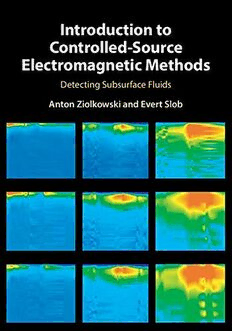Table Of ContentINTRODUCTION TO CONTROLLED-SOURCE
ELECTROMAGNETIC METHODS
This volume describes how controlled-source electromagnetic methods are used
to determine the electrical conductivity and hydrocarbon content of the upper few
kilometres of the earth, on land and at sea. The authors show how the signal-
to-noise ratio of the measured data may be maximised via suitable choice of
acquisition and processing parameters and selection of subsequent data analysis
procedures. Complete impulse responses for every electric and magnetic source
andreceiverconfigurationarederived,providingaguidetotheexpectedresponse
forrealdata.One-,two-andthree-dimensionalmodellingandinversionprocedures
for recovery of earth conductivity are presented, emphasising the importance
of updating model parameters using complementary geophysical data and rock
physics relations. Requiring no specialist prior knowledge of electromagnetic
theory,andprovidingastep-by-stepguidethroughthenecessarymathematics,this
book provides an accessible introduction for advanced students, researchers and
industrypractitionersinexplorationgeoscienceandpetroleumengineering.
anton ziolkowski is Professor of Petroleum Geoscience at the University of
Edinburgh. He co-invented the multichannel transient electromagnetic (MTEM)
surveying method for hydrocarbon reservoir detection and co-led the technology
spin-out. He is a member of the Institute of Electrical and Electronics Engineers
and the American Geophysical Union, an honorary member of the Society of
Exploration Geophysicists, a Fellow of the Royal Academy of Engineering
and a fellow of the Royal Society of Edinburgh. He has received the Conrad
Schlumberger and Desiderius Erasmus awards of the European Association of
GeoscientistsandEngineers.
evert slob is Professor of Geophysical Electromagnetic Methods at the Delft
University of Technology, where he teaches undergraduate and graduate classes.
HewasEditor-in-ChiefofthejournalGeophysicsandontheboardofdirectorsof
theSocietyofExplorationGeophysicistsfrom2013to2015,ofwhichheremains
a member. He is also a member of the European Association of Geoscientists and
EngineersandtheAmericanGeophysicalUnion.
INTRODUCTION TO
CONTROLLED-SOURCE
ELECTROMAGNETIC METHODS
Detecting Subsurface Fluids
ANTON ZIOLKOWSKI
TheUniversityofEdinburgh
EVERT SLOB
DelftUniversityofTechnology
UniversityPrintingHouse,CambridgeCB28BS,UnitedKingdom
OneLibertyPlaza,20thFloor,NewYork,NY10006,USA
477WilliamstownRoad,PortMelbourne,VIC3207,Australia
314–321,3rdFloor,Plot3,SplendorForum,JasolaDistrictCentre,NewDelhi–110025,India
79AnsonRoad,#06–04/06,Singapore079906
CambridgeUniversityPressispartoftheUniversityofCambridge.
ItfurtherstheUniversity’smissionbydisseminatingknowledgeinthepursuitof
education,learning,andresearchatthehighestinternationallevelsofexcellence.
www.cambridge.org
Informationonthistitle:www.cambridge.org/9781107058620
DOI:10.1017/9781107415904
©AntonZiolkowskiandEvertSlob2019
Thispublicationisincopyright.Subjecttostatutoryexception
andtotheprovisionsofrelevantcollectivelicensingagreements,
noreproductionofanypartmaytakeplacewithoutthewritten
permissionofCambridgeUniversityPress.
Firstpublished2019
PrintedintheUnitedKingdombyTJInternationalLtd.PadstowCornwall
AcataloguerecordforthispublicationisavailablefromtheBritishLibrary.
LibraryofCongressCataloging-in-PublicationData
Names:Ziolkowski,Anton,1946–author.|Slob,EvertC.(EvertCornelis),1962–author.
Title:Introductiontocontrolled-sourceelectromagneticmethods:detecting
subsurfacefluids/AntonZiolkowski(TheUniversityofEdinburgh),Evert
Slob(DelftUniversityofTechnology).
Description:Cambridge;NewYork,NY:CambridgeUniversityPress,2019.|
Includesbibliographicalreferencesandindex.
Identifiers:LCCN2018034518|ISBN9781107058620(hardback)|ISBN9781107634855(pbk.)
Subjects:LCSH:Earth(Planet)–Electricproperties.|Earth(Planet)–Magneticproperties.|
Earth(Planet)–Crust.|Electromagneticfields.|Electricprospecting.
Classification:LCCQE501.3.Z562019|DDC551–dc23
LCrecordavailableathttps://lccn.loc.gov/2018034518
ISBN978-1-107-05862-0Hardback
Additionalresourcesforthispublicationatwww.cambridge.org/csem.
CambridgeUniversityPresshasnoresponsibilityforthepersistenceoraccuracyof
URLsforexternalorthird-partyinternetwebsitesreferredtointhispublication
anddoesnotguaranteethatanycontentonsuchwebsitesis,orwillremain,
accurateorappropriate.
Contents
Preface pageix
NotationandConventions xi
1 Introduction 1
1.1 Ohm’sLawandResistivity 1
1.2 ResistivityofRocks 2
1.3 ResistivityAnisotropy 3
1.4 EffectofHydrocarbonsonResistivity:Archie’sLaw 3
1.5 ExampleWellLogs:P-WaveVelocityandResistivity 5
1.6 Controlled-SourceElectromagneticSurveys 7
1.7 SeismicandElectromagneticPropagation 8
1.8 One-DimensionalExampleofaBuriedResistiveLayer 11
1.9 One-dimensionalExampleofaBuriedMore-ConductingLayer 13
1.10 ExtractionofResistivitiesfromCSEMData:TheProblemof
Inversion 15
1.11 OutlineoftheBook 16
2 Sources,Receivers,AcquisitionConfigurationsandSource
TimeFunctions 18
2.1 TheCurrentDipoleSource 18
2.2 Receivers 20
2.3 Source–ReceiverConfigurations 22
2.4 TheAirWaveProblem 27
2.5 SourcesofEMNoise 28
2.6 SourceTimeFunctions 30
3 FourierAnalysisandLinearFilters 34
3.1 TemporalandSpatialFourierTransformation 34
3.2 ExampleofaPlaneWave 36
v
vi Contents
3.3 ResolutionandBandwidth 36
3.4 SimilarityTheorem 38
3.5 ImpulseFunction(δ) 38
3.6 TheSiftingProperty 39
3.7 Parseval’sTheoremandtheEnergyinaSignal 41
3.8 ConvolutionandtheConvolutionTheorem 43
3.9 LinearFiltersandImpulseResponse 44
3.10 EarthasaLinearFilter 47
3.11 Cross-Correlation,AutocorrelationandTime-Reverse 49
3.12 DerivativeTheorem 50
3.13 WavefieldTransformation 51
3.14 SamplingandAliasing 52
3.15 SamplingTheorem 53
3.16 DiscreteFourierTransform(DFT) 55
3.17 FilteringofSampledSignals:DiscreteConvolution 58
3.18 FrequencyDomainDeconvolution 59
3.19 TheWienerFilter 60
3.20 TimeDomainDeconvolution 63
3.21 LaplaceTransform 63
4 ElectromagneticFieldsinaHorizontallyLayeredVTIMedium 65
4.1 BasicEquations 66
4.2 TheElectromagneticFieldforaSourceinaVTIWholeSpace 77
4.3 TheElectromagneticFieldofaSourceinaVTIHalf-Space 86
4.4 TheElectromagneticFieldforMarineCSEM 97
4.5 TheElectromagneticFieldforLandCSEM 105
5 NumericalExamples 107
5.1 TheElectricFieldinaVTIWholeSpace 108
5.2 TheElectricFieldinaHomogeneousHalf-Space 113
5.3 TheElectricFieldinaMarineCSEMSetting 121
5.4 TheElectricFieldinaLandCSEMSetting 149
6 SourceControl 168
6.1 TheConvolutionalModelinCSEM 169
6.2 Pseudo-RandomBinarySequence 170
6.3 ConvolutionandDeconvolutionwithaPRBS 172
6.4 EffectofNoiseandDeconvolutionGain 173
6.5 HeavisideFunction,orStepFunction 177
6.6 SquareWaveFunction 183
6.7 SpecialPeriodicFunctions 184
Contents vii
7 DeepWaterCSEM 189
7.1 Introduction 189
7.2 AttenuationofElectromagneticSignalsinSeaWater 190
7.3 AcousticPositioning 191
7.4 Deep-TowedCurrentDipoleSource 192
7.5 Ocean-BottomReceiverNode 194
7.6 In-lineandBroadsideResponses 194
7.7 ReceiverOrientation 196
7.8 AcquisitionGeometries 198
7.9 Source–ReceiverSynchronisationandDataProcessing 198
7.10 AmplitudeversusOffsetExample 199
8 LandCSEMwithaTransientSourceSignal 202
8.1 Introduction 202
8.2 Acquisitionof2Dand3DCSEMData 203
8.3 DeconvolutionandRemovaloftheAirWave 205
8.4 IsotropicHalf-SpaceResponse 207
8.5 Signal-to-NoiseRatioofMTEMData 211
8.6 AttenuationofCulturalNoise 212
8.7 CSEMSurveyOveranUndergroundGasStorageSiteinFrance 216
8.8 ApparentResistivitiesfromTimetoPeakofImpulseResponse 218
8.9 ResistivitiesfromStepResponses 218
9 ShallowWaterCSEMwithaTransientSourceSignal 221
9.1 2DDataAcquisitionwithanOBC 221
9.2 ExamplesofOBCData 223
9.3 RemovalofSpatiallyCorrelatedNoise 223
9.4 Time-LapseMarineOBCDataRepeatability 227
9.5 Towed-StreamerMarineCSEMData 229
10 ForwardandInverseModellingofCSEMData 235
10.1 ForwardModelling 237
10.2 InverseModelling 241
11 RecoveryofResistivitiesfromCSEMData 244
11.1 EffectofOffset 244
11.2 AttenuationandModelParameterisation 245
11.3 ResistivitiesfromSeismicVelocities 246
11.4 ExamplefromNorthSeaHardingField 250
11.5 TestofMethodologyUsingRealCSEMData 251
11.6 ImplicationsforElectromagneticSurveyPlanning 253
11.7 ExampleInversionofDeepWater3DCSEMData 253
viii Contents
12 EfficientCSEM 258
12.1 GeneralConsiderations 259
12.2 Land 260
12.3 ShallowWaterMarine 262
12.4 DeepWaterMarine 263
12.5 SourceTimeFunction 263
12.6 Conclusions 264
AppendixA TheElectricFieldinaVTIWholeSpace 265
AppendixB TheElectromagneticFieldinaVTILayeredMedium 268
AppendixC Green’sFunctionsandTheirDerivatives 284
AppendixD TheFinalValueTheorem 289
References 291
Index 299
Colourplatesectionfoundbetweenpages176and177
Preface
The aim of this book is to make the benefits of controlled-source electromagnetic
(CSEM) methods more widely appreciated by geoscientists and engineers, and to
provideanapproachthathassoundtheoreticalfoundationsandacleardescription
ofthepracticalaspectsofCSEMdataacquisition,processingandinterpretation.
CSEMmethodsareusedtoexploreforcontrastsinsubsurfaceelectricalconduc-
tivity and are especially useful to search for subsurface fluids, including resistive
hydrocarbons and conductive saline water. For example, CSEM methods have the
potentialtodetecthydrocarbonsbeforedrilling.Sincethreeoutoffourexploration
wells contain no hydrocarbons, it may pay to carry out CSEM exploration before
drillingtoincreasethelikelihoodoffindingoilorgas.Salinewateratdepthsof2–4
kmisusuallyhotenoughtoprovideheatforbuildings.Inmanycountries,heating
consumes more energy than transport and electricity generation combined. CSEM
has the potential to find the geothermal resources that can reduce our dependence
onfossilfuels.
Theoretical work on the concept of CSEM methods and the use of loops and
antennas for exploration dates back to the 1950s. Onshore techniques were devel-
oped commercially and by the academic community. Offshore techniques were
developed initially by academics. By 1991, Misac N. Nabighian was able to bring
allthisworktogetherinthetwo-volumebookElectromagneticMethodsinApplied
Geophysics,publishedbytheSocietyofExplorationGeophysics.Inthefirstdecade
ofthetwenty-firstcentury,CSEMbecameatoolforde-riskingexplorationdrilling
for deep-water prospects. Compared with seismic exploration, however, CSEM is
still in its infancy and is still expensive per data point. There is clearly room for
development.
It is now well understood in seismic exploration that broad bandwidth data are
essentialforgoodimagingofsubsurfacestructures,whetherthedataareprocessed
in the time domain or the frequency domain. A key concept is the idea of an
impulsive source and the resulting impulse response of the earth. This concept is
ix

